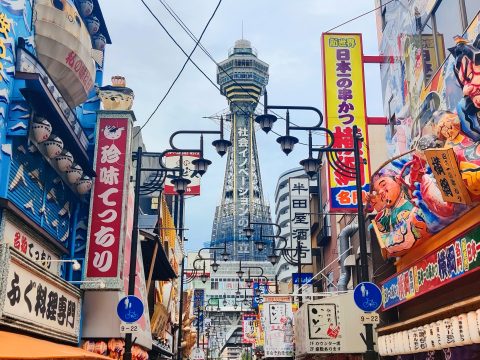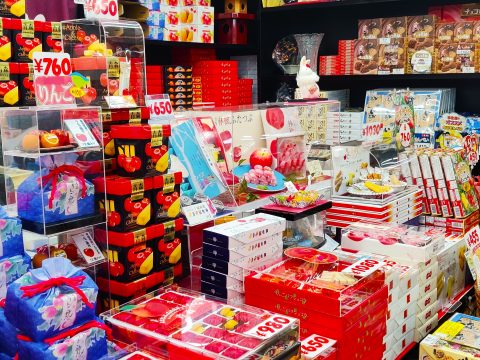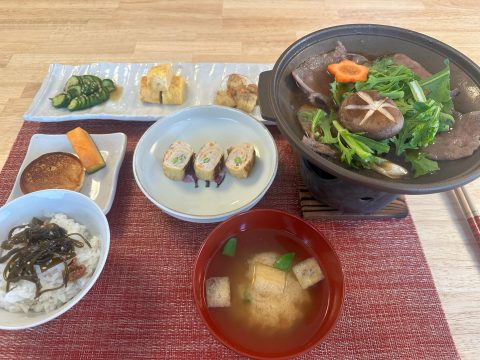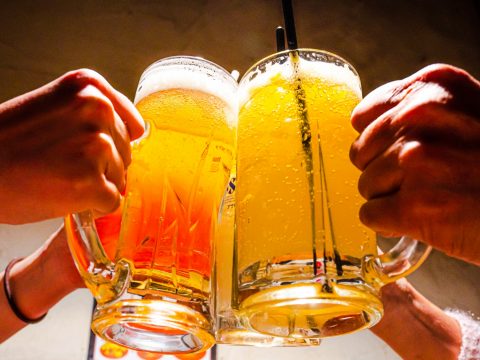Kaitenzushi(回転寿司)
JAPANESE FOODS
13.12.2024

If you would ask people from anywhere in the world, what Japan’s most famous dish is, they will probably all say ‘sushi’. It’s Japan’s most famous dish, but unlike what many people think, it’s definitely not something that many Japanese people eat regularly. There is an endless variety of sushi and many ways to enjoy it. The most exciting way is definitely having an ‘omakase’ course at a fancy restaurant. This means that instead of choosing items from a menu, you leave it up to the chef, who will prepare a course, based on seasonal ingredients and the best fish that was available at the market that day. As this is a very special experience, it can also be quite a pricey one. Therefore, many Japanese people are more likely to buy sushi at take-out shops, supermarkets or visit another type of restaurant: ‘kaitenzushi’.
What is ‘kaitenzushi’?
Often translated to ‘conveyor belt sushi’ or more literally ‘revolving sushi’, these restaurants offer a wide variety of sushi for a very affordable or sometimes even ridiculously cheap price. Most kaitenzushi restaurants charge 100 to 180 yen per plate of 2 pieces of sushi. Yes, you can order per plate! This makes it the perfect location to eat with family or a group of friends, as everyone can order whatever and as much as they want, without breaking the bank. The downside to affordable restaurants that are convenient for groups? Many people like going there, especially during lunchtime and dinnertime. So try to make a reservation by phone or app, avoid peak hours or go there about 1 hour in advance to get a reservation ticket.

From conveyor belt to delivery belt
Although kaitenzushi is famous for constantly having plates of sushi revolving on a conveyor belt along the tables, times have changed and so has the conveyor belt. Instead of picking up plates from the conveyer belt whenever something interesting passes your table, you can now place an order on a tablet at your table. It will then be delivered on the delivery belt. This system was implemented at restaurants in less crowded areas to prevent food waste. During the pandemic however, most restaurants switched to this system, as it is also more hygienic as your sushi hasn’t been revolving for a while past a large number of strangers. As less people ate out during the pandemic, it was also the perfect moment for restaurants to make improvements like this.
Common sushi, uncommon sushi and anything that’s not sushi
What also makes kaitenzushi ‘less authentic’ sushi, is the variety. There is a large assortment of common and more authentic sushi in different styles, such as ‘nigiri’ (fish on top of rice), ‘maki’ (fish rolled in rice and seaweed) and ‘gunkan’ (‘battleship’ shape, which is fish on top of rice with seaweed wrapped around it). Besides that, there are more and more interesting combinations nowadays. A few of my personal favorites are cheeseburger nigiri (rice with a meat patty and a tiny slice of cheese), karaage gunkan (fried chicken gunkan) and combinations made with prosciutto, tempura, cheese, avocado and even kimchi. Last but not least, there are usually many side dishes to choose from. Again, some are more Japanese than others, but the most common ones include, miso soup, takoyaki, French fries, ramen, udon, fried chicken and omelet. And don’t leave without trying the desserts!
All in all, kaitenzushi might not be the most authentic and traditional type of Japanese food, but it is definitely part of Japanese culture. It’s popular among Japanese people and foreigners, it’s affordable, fast and fun!

Mietta Varszegi
Mietta grew up in the Netherlands and moved to Japan in 2019 to work as an English teacher. Now, she has 3 different jobs, explores Tokyo on days off and takes trips around Japan whenever she can. But everywhere in Japan, the goal is the same: visit as many shrines, castles and parks as possible and eat everything!
Read previous articles by the writer
Read latest articles
KEYWORDS
- # PICKPICK
- # Resume
- # alcohol
- # Rice
- # Soup
- # winter food
- # Fast Food
- # seafood
- # spicy foods
- # raw food
- # fermented food
- # Transportation
- # MEAT
- # Edo culture
- # suits
- # clothing
- # drink
- # fish
- # seasoning
- # Japanese New Years Foods
- # Toshikoshi soba
- # Osechi Ryori
- # Ozoni
- # Christmas
- # Japanese fusion pasta
- # Wafu Pasta
- # Japanese Hot Pot
- # なべ
- # 鍋
- # Miyazaki
- # Chicken Nanban
- # Karamen
- # Autumn Wagashi
- # Mushi-yokan
- # Imo-yokan
- # Japanese Autumn Fruits
- # Autumn
- # Vending Machine
- # fall
- # dango
- # Chestnut rice
- # saury
- # Mushroom
- # Rice vinegar
- # Japanese condiments
- # 調味料
- # Sake
- # Mirin
- # Soy sauce
- # Japanese Noodles
- # Udon
- # Ramen
- # Yakisoba
- # Soba
- # Japanese Seaweed
- # 海藻
- # かいそう
- # Payslip
- # Training
- # Japanese summer foods
- # 和菓子
- # Wagashi
- # ryokucha
- # 夏
- # 飲み物
- # Ramune
- # ラムネ
- # Pokari Sweat
- # ポカリスエット
- # Calpis
- # カルピス
- # Mugicha
- # ume
- # 梅
- # うめ
- # umeshu
- # job hunting
- # tofu
- # Recruitment in Japan
- # miso
- # Japanese cuisine
- # Yellowtail and bonito
- # Children’s Day
- # Kashiwa Mochi
- # Chimaki
- # fruits
- # Kusamochi
- # Types of Agriculture in Japan
- # bread
- # パン
- # パン屋さん
- # japanese bread
- # shokupan
- # meal blead
- # anko bread
- # 桜
- # さくら
- # cherry blossom
- # visa
- # hanami
- # omotenashi
- # sakura
- # おもてなし
- # Japanese hospitality
- # oshibori
- # wet hand towel
- # hand towel
- # restaurant
- # Commuting in Japan
- # Women-only cars
- # Exit gate
- # japanese train
- # train
- # valentine
- # Japanese sweets
- # 朝食
- # Japanese Breakfast
- # Breakfast
- # Japanese
- # 日本
- # healthy
- # persimmons
- # hoshigaki
- # HR
- # work in Japan
- # jinji ido
- # corporate systems
- # Japanese work culture
- # bento
- # ekiben
- # shinkansen
- # omiyage
- # train station
- # Japanese culture
- # work culture
- # mentaiko
- # umeboshi
- # Japanese snacks
- # potato chips
- # Japanese potato chips
- # Japanese writing
- # seaweed
- # konbu
- # ocean foods
- # shio konbu
- # dashi
- # miso soup
- # food processing
- # pear
- # nashi
- # sweet potato
- # japanese sweet potato
- # stingray
- # satsuma imo
- # food value chain
- # homecooking
- # agriculture
- # Japanese homecooking
- # farming
- # nikujaga
- # shojin ryori
- # meat and potatoes
- # traditional foods
- # comfort food
- # buddhist food
- # manufacturing
- # factory
- # eihire
- # vegetarian
- # food and beverage
- # izakaya
- # yatai
- # japanese festival
- # taiyaki
- # matsuri
- # summer
- # Ikayaki
- # smart agriculture
- # shaved ice
- # kakigori
- # かき氷
- # summer dessert
- # Japan
- # Japanese foods
- # dessert
- # fruit
- # matcha
- # icecream
- # Pikcup
- # Pikc up
- # Pcikup
- # skilled labor visa
- # working visa japan
- # Dineer Table in Japan
- # Japanese manner
- # Japanese food
- # Japanese Table Manner
- # Chopsticks
- # Japanese traffic signs
- # traffic information
- # road rules in Japan
- # chocolate
- # green tea
- # Osaka
- # Work Japan
- # Japanese company
- # ikura
- # sushi
- # nigiri
- # wasabi
- # PCIK
- # PICK UP
- # PICK
- # PICKUP







